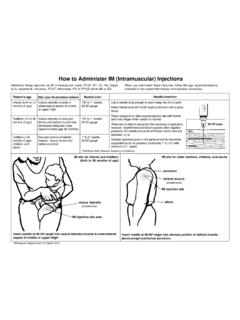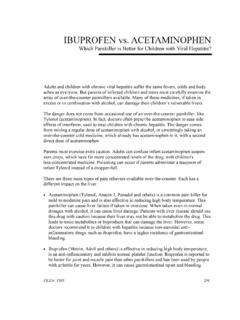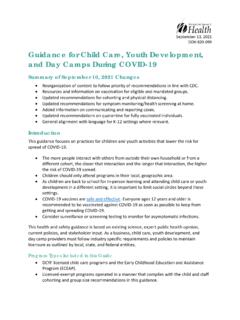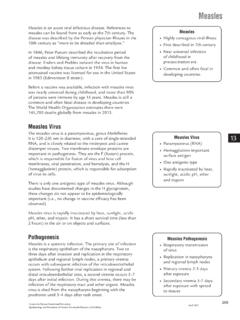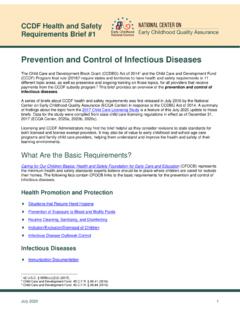Transcription of UNIT 1 Introduction to Infectious Diseases
1 PKIDs IDW Instructor s Background Text 1 unit 1: Introduction to Infectious Diseases unit 1 Introduction to Infectious Diseases Instructor s Background Text PKIDs Infectious disease Workshop Made possible by grants from the Northwest Health Foundation, the Children s vaccine Program at PATH and PKIDs PKIDs IDW Instructor s Background Text 2 unit 1: Introduction to Infectious Diseases Acknowledgements Producing this workshop has been a dream of ours since PKIDs inception in 1996. This pro-ject was two years in the making, and many people helped us reach our goal. It s not done, be-cause it is by nature a living document that will evolve as science makes strides in the research of Infectious Diseases , but it s a great beginning.
2 Without the funding and support of the Northwest Health Foundation and the Children s Vac-cine Program at PATH (Program for Appropriate Technology in Health), this would have been an impossible task. Dr. Katherine Vaughn, PKIDs Medical Director and Dr. Karen Steingart, scientific advisor to PKIDs, provided excellent guidance through their editorial oversight and knowledgeable contributions to the Infectious disease Workshop. We are indebted to the following individuals who cheerfully gave us hours of their time and access to their resources: the American Society for Microbiology; Kathy A. Bobula, , Co-ordinator, Early Childhood Education, Clark College, Vancouver, WA; Claudia Bratt, elemen-tary school teacher, Truman Elementary, Vancouver, WA; Sue Campbell, Early Childhood Educator, Kindercare, Vancouver, WA; many wonderful and helpful people at the Centers for disease Control and Prevention, Atlanta, GA; Rachel Coyle, Case Aide and Residential Care Staff Lead, Jonathan s Place; Tammy Dunn, Early Childhood Director, Portland Christian Schools, Portland, OR; Bruce Gellin, , Director of the National vaccine Program Office in the Office of the Assistant Secretary for Health, Department of Health and Human Services.
3 Shannon Harrison, , Internal Medicine and Infectious Diseases , Teton Hospital, Jackson, WY; the Immunization Action Coalition; Brad Jensen, , Southwest Washington Medical Center Pathology Department, Vancouver, WA; Edgar Marcuse, , Professor of Pediatrics, University of Washington and Director of Medical Services, Seattle Children s Hospital and Regional Medical Center; Zack Mittge, law student, University of Oregon; the National Net-work for Immunization Information; Paul Offit, , Chief, Section of Infectious Diseases and the Henle Professor of Immunologic and Infectious Diseases at The Children s Hospital of Philadelphia; Carol Porter, Red Cross health room volunteer, Garland Independent School Dis-trict, Garland, TX; Sarah Theberge, Curriculum Instructor, Early Childhood Education, Clark College, Vancouver, WA; James Whorton, , Professor, Department of Medical History and Ethics, University of Washington School of Medicine.
4 We thank the following for providing nonprofit rates for their microscopic images: Dennis Kunkel Microscopy, Inc., and Science Photo Library/Photo Researchers, Inc. (Cover photo: Dennis Kunkel Microscopy, ) Additional funding for this project provided by PKIDs (Parents of Kids with Infectious Dis-eases). PKIDs 2004-2008 PKIDs IDW Instructor s Background Text 3 unit 1: Introduction to Infectious Diseases Table of Contents Warning: This section contains certain disease -related images that may not be suitable for young children. Introduction .. 4 About Infectious Diseases .. 5 Historic Perspective .. 6 About Antibiotics .. 9 Humans vs. Microbes.
5 10 Bacteria and Viruses How They Work .. 13 Fun (And Some Not-So-Fun) Facts About Infectious Diseases .. 16 Diseases in the United States and Around the World .. 20 Influenza (the Flu) .. 21 Pertussis (Whooping Cough) .. 25 Rubella (German Measles) .. 27 Hib (Haemophilus influenzae type b) .. 29 Diphtheria .. 31 Measles .. 33 Varicella (Chickenpox) .. 35 Tetanus .. 39 Mumps .. 41 Meningococcal disease .. 43 Polio .. 47 Hepatitis A .. 50 Hepatitis B .. 53 Hepatitis C .. 56 Tuberculosis (TB) .. 59 Cytomegalovirus (CMV) .. 61 Herpes .. 63 HIV/AIDS .. 65 Smallpox .. 73 West Nile Virus .. 83 Anthrax .. 111 Bibliography .. 141 For educational activities and resources, please visit This publication contains the opinions and ideas of its authors.
6 It is intended to provide helpful and informative material on the subject matter covered. Any information obtained from this workshop is not to be construed as medical or legal advice. If the reader requires personal assistance or advice, a competent professional should be consulted. The authors specifically disclaim any responsibility for any liability, loss, or risk, personal or otherwise, which is incurred as a consequence, directly or indirectly, of the use and application of any of the contents of this workshop. PKIDs IDW Instructor s Background Text 4 unit 1: Introduction to Infectious Diseases Introduction PKIDs (Parents of Kids with Infectious Diseases ) is a national nonprofit agency whose mission is to educate the public about Infectious Diseases , the methods of prevention and transmission, and the latest advances in medicine; to eliminate the social stigma borne by the infected; and to assist the families of the children living with hepatitis, HIV/AIDS, or other chronic, viral infec-tious Diseases with emotional, financial and informational support.
7 Remaining true to our mission, we have designed the Infectious disease Workshop (IDW), an educational tool for people of all ages and with all levels of understanding about Infectious dis-eases. In this workshop, you will learn about bacteria and viruses, how to prevent infections, and how to eliminate the social stigma that too often accompanies Diseases such as HIV or hepatitis C. We hope that both instructors and participants come away from this workshop feeling comfort-able with their new level of education on Infectious Diseases . The IDW is designed to train-the-trainer, providing instructors not only with background ma-terials but also with age-appropriate activities for the participants. Instructors do not need to be professional educators to use these materials.
8 They were designed with both educators and lay-persons in mind. The IDW is comprised of a master Instructor s Background Text, which is divided into six units: Introduction to Infectious Diseases , disease Prevention, Sports and Infectious disease , Stigma and Infectious disease , Civil Rights and Infectious disease , and Bioterrorism and Infec-tious disease . For each unit , instructors will find fun and helpful activities for participants in five age groups: 2 to 6 years of age, 6 to 9 years of age, 9 to 12 years of age, 13 to 18 years of age and adults. We welcome any questions, comments, or feedback you may have about the IDW or any other issue relating to Infectious Diseases in children. PKIDs Box 5666 Vancouver, WA 98668 voice: (360) 695-0293 or toll-free 877-557-5437 fax: (360) 695-6941 email: website: PKIDs IDW Instructor s Background Text 5 unit 1: Introduction to Infectious Diseases PKIDs Infectious disease WORKSHOP About Infectious Diseases Infectious Diseases are scary in part because most of us don t know anything about them.
9 They are also scary because they can be lethal. Unless we happen to be healthcare professionals, or our loved ones have been personally affected by such Diseases , we only think about them when they threaten our families, our communities or ourselves. This module helps advance our understanding of Infectious Diseases and provides perspective on the role they play in our lives. What Is An Infectious disease ? Weber State University Online explains it this way: Although many complex factors surround the definition of Infectious disease , some generalizations can be made. An infection can be defined as a state in which microor- ganisms, bacteria, viruses, fungi and parasites survive and reproduce in the host's tissues.
10 In many instances no noticeable changes (or symptoms) are apparent. When the organism produces sufficient tissue damage through many different mech- anisms, the definition of Infectious disease then applies. As in hepatitis, when liver cells are invaded and damaged by the virus. Symptoms then result and can be determined through clinical examination and laboratory tests. In other words, a microorganism (an organism that s too small to be seen with the naked eye) latches onto or inside of us, reproduces, and does some damage. Sometimes, the actual damage is done not by the microorganism, but by our own immune systems fighting the invaders.

